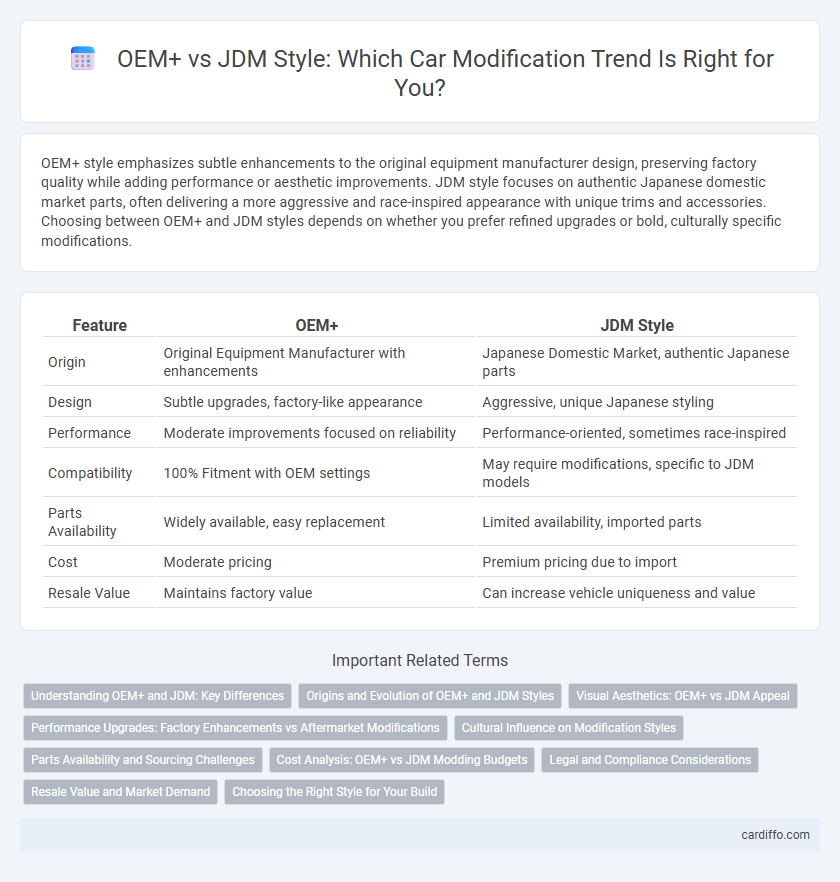OEM+ style emphasizes subtle enhancements to the original equipment manufacturer design, preserving factory quality while adding performance or aesthetic improvements. JDM style focuses on authentic Japanese domestic market parts, often delivering a more aggressive and race-inspired appearance with unique trims and accessories. Choosing between OEM+ and JDM styles depends on whether you prefer refined upgrades or bold, culturally specific modifications.
Table of Comparison
| Feature | OEM+ | JDM Style |
|---|---|---|
| Origin | Original Equipment Manufacturer with enhancements | Japanese Domestic Market, authentic Japanese parts |
| Design | Subtle upgrades, factory-like appearance | Aggressive, unique Japanese styling |
| Performance | Moderate improvements focused on reliability | Performance-oriented, sometimes race-inspired |
| Compatibility | 100% Fitment with OEM settings | May require modifications, specific to JDM models |
| Parts Availability | Widely available, easy replacement | Limited availability, imported parts |
| Cost | Moderate pricing | Premium pricing due to import |
| Resale Value | Maintains factory value | Can increase vehicle uniqueness and value |
Understanding OEM+ and JDM: Key Differences
OEM+ emphasizes subtle enhancements to factory specifications, preserving original design and reliability while improving performance or aesthetics. JDM style focuses on authentic Japanese Domestic Market components, offering unique parts and aggressive styling not always available outside Japan. Understanding these differences helps enthusiasts choose between refined upgrades (OEM+) and distinct cultural authenticity (JDM).
Origins and Evolution of OEM+ and JDM Styles
OEM+ style originated from enhancing factory specifications by adding subtle performance and aesthetic upgrades while maintaining the vehicle's original design integrity, emphasizing quality and reliability. JDM style evolved from the Japanese Domestic Market culture, showcasing bold modifications that highlight unique aftermarket parts and aggressive tuning specific to Japan's car scene. Both styles reflect distinct automotive philosophies: OEM+ values refinement and subtlety, whereas JDM embraces cultural authenticity and expressive customization.
Visual Aesthetics: OEM+ vs JDM Appeal
OEM+ style emphasizes subtle enhancements that maintain the original manufacturer's design language, offering refined visual aesthetics with a clean, understated look. JDM style showcases bold, aggressive modifications inspired by Japanese domestic market vehicles, often featuring vibrant colors, aftermarket body kits, and distinctive decals for a striking visual impact. Both approaches prioritize visual appeal but cater to different tastes: OEM+ for elegance and cohesion, JDM for standout, culture-rich expression.
Performance Upgrades: Factory Enhancements vs Aftermarket Modifications
OEM+ performance upgrades involve factory enhancements that maintain the vehicle's original engineering integrity while providing reliable improvements in power, handling, and efficiency. JDM style focuses on aftermarket modifications sourced from Japanese Domestic Market parts that prioritize aggressive tuning, unique aesthetics, and performance gains often beyond the stock specifications. While OEM+ parts ensure compatibility and durability, JDM modifications offer higher potential for customization and heightened performance but may require additional tuning and maintenance.
Cultural Influence on Modification Styles
OEM+ and JDM style modifications both reflect distinct cultural influences shaping automotive customization trends. OEM+ modifications emphasize subtle enhancements that preserve brand authenticity, a preference rooted in Western automotive culture valuing refinement and factory excellence. In contrast, JDM style modifications showcase bold, performance-driven changes inspired by Japanese street racing culture, highlighting individuality and aggressive aesthetics.
Parts Availability and Sourcing Challenges
OEM+ style parts, often based on original manufacturer designs with subtle upgrades, benefit from relatively stable availability through authorized dealers and trusted aftermarket vendors, making sourcing more predictable. JDM style parts, sourced directly from Japanese domestic market vehicles, present challenges such as limited export channels, variable authenticity, and higher shipping costs, which can complicate procurement. Enthusiasts often face longer lead times and higher prices when acquiring JDM components, whereas OEM+ parts typically offer more consistent supply and compatibility.
Cost Analysis: OEM+ vs JDM Modding Budgets
OEM+ modifications typically involve higher costs due to premium parts sourced directly from original equipment manufacturers, ensuring quality and fitment but raising overall expenses. JDM style builds tend to be more budget-friendly, leveraging aftermarket or imported components that emulate Japanese domestic market aesthetics without the high price tag of genuine OEM parts. Cost analysis reveals OEM+ builds favor long-term durability, while JDM mods offer a more accessible entry point for enthusiasts seeking style-driven upgrades on tighter budgets.
Legal and Compliance Considerations
OEM+ modifications typically comply with local vehicle regulations as they involve upgrading factory parts or approved aftermarket components, ensuring road legality and insurance approval. JDM style modifications often include parts designed for the Japanese market that may not meet regional emissions, safety standards, or certification requirements, potentially leading to legal issues or failed inspections. Owners must verify compliance with national laws and consult vehicle registration authorities to avoid penalties or insurance disputes.
Resale Value and Market Demand
OEM+ style modifications typically maintain higher resale value due to their subtle enhancements and closer alignment with original manufacturer specifications, appealing to a broader market. In contrast, JDM style modifications, known for their bold, Japanese Domestic Market aesthetics and performance parts, attract niche enthusiasts but may limit resale potential outside this community. Market demand favors OEM+ for buyers seeking reliability and originality, while JDM style caters to dedicated fans willing to invest in distinctive, culturally specific upgrades.
Choosing the Right Style for Your Build
Choosing the right style for your build hinges on understanding the core differences between OEM+ and JDM aesthetics, where OEM+ focuses on subtle enhancements maintaining factory quality and fitment, while JDM style emphasizes bold, authentic Japanese market components for a more aggressive look. Consider your goals for originality versus cultural expression, as OEM+ offers a clean, refined appearance suited for daily drivers, whereas JDM imports standout parts like widebody kits and vintage badges that capture the essence of Japanese car culture. Evaluating compatibility with your vehicle's existing design and your long-term vision ensures a cohesive build tailored to performance, resale value, and personal style preferences.
OEM+ vs JDM Style Infographic

 cardiffo.com
cardiffo.com